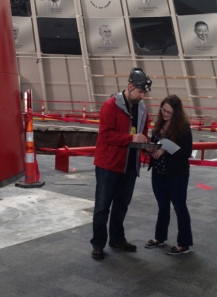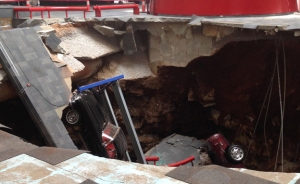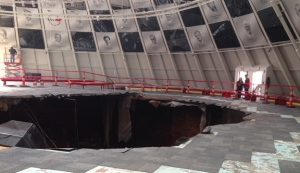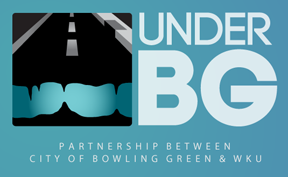Biology
WKU karst, engineering expertise highlighted at museum sinkhole
- Thursday, February 20th, 2014
WKU’s Ogden College of Science and Engineering prides itself on providing hands-on, real-world experiences for students through courses taught by faculty members who are experts in their fields.

Dr. Jason Polk and Dr. Leslie North have been at the National Corvette Museum almost daily since a sinkhole swallowed eight Corvettes on Feb. 12.
When a massive sinkhole at the National Corvette Museum’s Skydome swallowed eight Corvettes on the morning of Feb. 12, WKU faculty and students put their education, training and expertise to work.
“As sinkholes go it really wasn’t that different or uncommon, it was just where it was and the fact that it had Corvettes in it that made it unique,” said Dr. Jason Polk, assistant professor in WKU’s Department of Geography and Geology.
Dr. Polk and Dr. Leslie North were among the first WKU geoscience faculty members on the scene Feb. 12 and have been at the museum almost daily since then as they continue to assess the sinkhole from a karst science point-of-view and make plans for outreach efforts related to sinkholes.
“Our role now is basically to try and help with some information about the collapse feature, some information and ways to remediate and fix it, and also assist with sinkhole expertise with regard to safely getting in and retrieving the Corvettes,” Dr. Polk said.
In the past 20 years, WKU Engineering faculty member Matt Dettman has been developing techniques to repair sinkholes. Dettman was on his way to view a sinkhole in a residential development on Feb. 12 when he heard about the museum.
“In the engineering community this is not unexpected,” said Dettman, the James D. Scott Professor of Civil Engineering. “We didn’t expect a sinkhole to open up at the Corvette museum but we know they exist.”
Dettman was one of several engineers who responded to the Corvette museum. “You want multiple eyes on this issue from multiple perspectives,” he said.

WKU faculty and students have been assisting National Corvette Museum officials in assessing the sinkhole and developing plans to remove the cars.
In the hours after the sinkhole opened, engineers, geologists and others worked to assess the sinkhole, identify the structural integrity of the Skydome, develop a plan for how to proceed and how to assemble a team to remove the Corvettes and repair the damage.
“A role I played was looking at the foundation and how much of the spire was undermined,” Dettman said. “Was the sinkhole spreading out to undermine perimeter of the dome itself?”
Students from WKU’s mechanical engineering program used their quadcopter to provide an upclose look inside the sinkhole for geologists, engineers and museum officials.
“We worked with WKU Engineering and students came out with the quadcopter to film footage of the sinkhole,” Dr. Polk said. “It was much safer to have them use that device rather than us go down and look at it.”
“We were able to take this in and gather all this information and give it to them within half an hour,” said Darren Tinker, one of the mechanical engineering students who built the quadcopter.
Like the WKU faculty members, Tinker also sprung into action once he heard about the sinkhole. “I sprinted down the hall to ask the professor if we could get our partners out of class and he said ‘Why do you need them?’ I said because there’s a sinkhole in the museum and we are gonna check it out with the quad,” Tinker said.

Dr. Jason Polk and Dr. Leslie North collect data at the sinkhole inside the National Corvette Museum’s Skydome.
A quadcopter video shot by Tinker, Zachary Lancaster, Jessie Reeser and Will Johnson has been viewed more than 600,000 times on the National Corvette Museum’s YouTube channel.
“We had never flown it with the camera and it had been two months since he’d flown this thing because of winter break,” Tinker said. “We’re trying to make sure it doesn’t run into any wires or anything that’s falling off. It’s an adrenaline rush for what it was. I think what we did was thoroughly appreciated.”
Dr. Polk agreed. “Really great technology and development,” he said. “Proud of the students and what they achieved with that type of collaboration.”
While crews continue their work inside the museum on a plan to remove the Corvettes, WKU faculty members will continue their work to educate WKU students and the public on southcentral Kentucky’s karst landscape.
“It’s been a hot lecture topic since that day. Every class I teach has some sort of relationship to a sinkhole,” Dettman said, noting that he’s teaching construction management, foundation engineering and construction equipment and methods courses this semester. “We could talk about it the rest of the semester, but we won’t.”
Dr. Polk and Dr. North expect to keep talking about the sinkhole and about how one of Bowling Green’s top tourist attractions remains a safe place to visit.
In the next few weeks, Dr. North will be coordinating workshops for adults and children at the Corvette museum to explain sinkholes and the area’s karst features.
“WKU is really glad to help with part of that,” Dr. Polk said. “We want to let people know it’s safe to come out here.”
WKU also has partnered with the City of Bowling Green on a karst and groundwater awareness website. Find out more about what’s Under BG at http://www.underbgky.org/
Contact: Jason Polk, (270) 745-5015; or Matt Dettman, (270) 745-2462.


